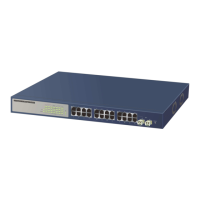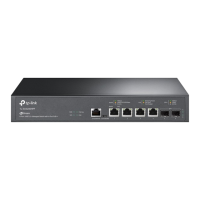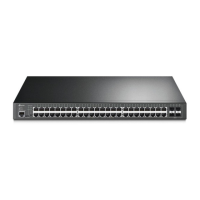65
The possible eld values are:
– Root — Provides the lowest cost path to forward packets to the root device.
– Designated — Indicates the port or LAG through which the designated device is attached to the LAN.
– Alternate — Provides an alternate path to the root device from the root interface.
– Backup — Provides a backup path to the designated port path toward the Spanning Tree leaves. Backup ports occur
only when two ports are connected in a loop by a point-to-point link or when a LAN has two or more connections
connected to a shared segment.
– Disabled — Indicates the port is not participating in the Spanning Tree.
Mode — Indicates the STP mode by which STP is enabled on the device. The possible eld values are:
– Classic STP — Classic STP is enabled on the device. This is the default value.
– Rapid STP — Rapid STP is enabled on the device.
– Multiple STP — Multiple STP is enabled on the device.
Type — Indicates whether the port is a Boundary or Master port. The possible eld values are:
– Boundary Port — Indicates that the port is a Boundary port. A Boundary port attaches MST bridges to LANs in an
outlying region. If the port is a Boundary port, this eld also indicates whether the device on the other side of the link is
working in RSTP or STP mode
– Master Port — Indicates the port is a master port. A Master port provides connectivity from a MSTP region to the
outlying CIST root.
Interface Priority — Denes the Interface priority for the specied instance. The default value is 128.
Path Cost — Indicates the port contribution to the Spanning Tree instance. The range should always be 1-200,000,000.
Port State — Indicates whether the port is enabled for the specic instance. The possible eld values are:
– Enabled — Enables the port for the specic instance.
– Disabled — Disables the port for the specic instance.
Designated Cost — Indicates that the default path cost is assigned according to the method selected on the Spanning
Tree Global Settings page.
Designated Bridge ID — Displays the ID of the bridge that connects the link or shared LAN to the root.
Designated Port ID — Displays the ID of the port on the designated bridge that connects the link or the shared LAN to
the root.
Remain Hops — Indicates the hops remaining to the next destination.
2. Select the Instance.
3. Modify the Port Priority and Path Cost.
4. Click . The device information is updated.
To add new interface settings for MSTP:
Figure 93: MSTP Interface Settings Page
1. Dene the instance properties elds.
2. Click . The interface settings are added to the
list in the MSTP Interface Settings Page. The device
information is updated.

